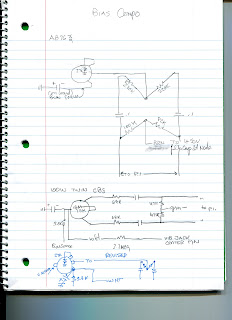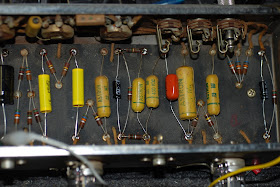Here's some info from my shop notebook. I'm working on a late model Twin Reverb that has an extra tab on the bias control pot with three things attached to it. There's the bias feed through a 3.3k resistor, an electrolytic cap with the positive to ground (it was an 80/75 so I ended up with a 100/160 number) and a lead going off to the vibrato pedal RCA connector center post.
After thinking about converting this to the more desirable level adjust and studying it a bit I went ahead and converted it as you see in the third sketch, the one in ink. Vacate the extra post, connect the supply, capacitor and vibrato pedal lead to the lower pot tab, the center tab now supplies bias voltage to the revised phase inverter setup, and the upper tab is grounded through a 27k resistor.
When you think about it, the extra tab on the bias pot makes it easier to construct the bias balance setup, but if you're only going for a level adjust it is unnecessary.
Monday, May 28, 2012
Wednesday, May 9, 2012
Major Hassle
Every once in a while something rarely seen shows up and that was the case with this Marshall Major. It's a 200w guitar amp head with a minimum of circuitry, kinda like a one channel Bassman with a 200w power section.
It's quite heavy and most of the weight is concentrated at one end which makes it awkward to move around. As a result I've got tennis elbow and a sore back after jackassing it out to the truck, into the house, out to the truck, back into the house for something I forgot, back in the truck and back to where it came from.
All that was necessary was to remove the so called "death cap" and disable the line reverse switch. The owner wanted it all documented so I took photos all the way along and put them on a CD for him.
It gave me a chance to dig out my AC43-13 aviation manual and brush up on my wire bundle lacing technique which I hadn't done since A&P school back in 1980. I had a spool of waxed lacing cord on my workbench courtesy of McDonnell Douglas, and it was a matter of a few minutes of happy reading to remember how to do the ties and knots. For safety's sake I put a little clear nail polish on each tie that was so tastefully executed.
It's quite heavy and most of the weight is concentrated at one end which makes it awkward to move around. As a result I've got tennis elbow and a sore back after jackassing it out to the truck, into the house, out to the truck, back into the house for something I forgot, back in the truck and back to where it came from.
All that was necessary was to remove the so called "death cap" and disable the line reverse switch. The owner wanted it all documented so I took photos all the way along and put them on a CD for him.
It gave me a chance to dig out my AC43-13 aviation manual and brush up on my wire bundle lacing technique which I hadn't done since A&P school back in 1980. I had a spool of waxed lacing cord on my workbench courtesy of McDonnell Douglas, and it was a matter of a few minutes of happy reading to remember how to do the ties and knots. For safety's sake I put a little clear nail polish on each tie that was so tastefully executed.
Thursday, May 3, 2012
Rationalizing a 1960 Vibrolux amp
This amp is the second in a trio of estate finds belonging to a friend of mine who owns a music shop. The first through the mill was a 1954 Deluxe about which more anon.
This amp is a May, 1960 5F11 Vibrolux that is in beautiful cosmetic shape but which has been hacked a bit. It's not ready for a clean bill of health yet but the patient did not die on the operating table. It has the original output transformer but the power transformer has been changed for something or other, and a 12" ceramic speaker has been installed in place of the original Jensen P10R.
This is but a preliminary report with pics to satisfy some catcalls from the audience.
After redoing the transformer wiring and removing a couple of feet of excess wiring, it needed an adjustable bias and some oscillator capacitors to get the vibrato working at its best. The sweet spot seemed like about 23 ma per side, and it works better if you control it with a foot switch.






























